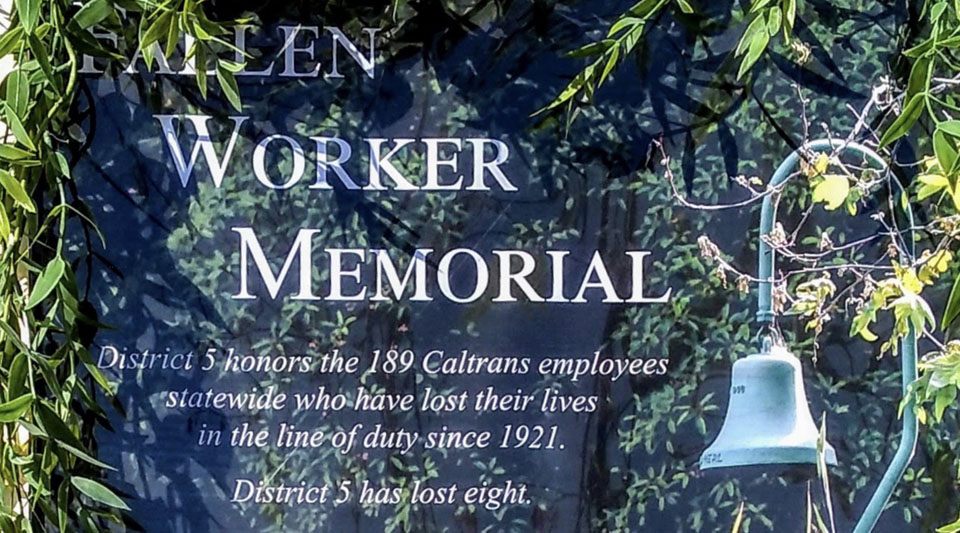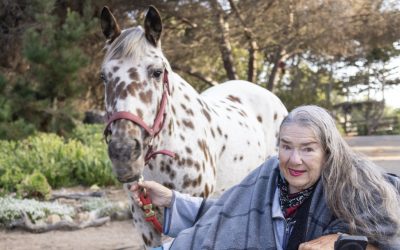Fifteen years, that’s 15 long, and for the purposes of this article, long and good years, since the men and women working for the Central Coast Caltrans District (District 5) have had a work-related death among their ranks.
It’s been so long in fact that a measure of road safety is taken for granted by local motorists in a region where urban and rural boundaries, and fluctuating speed zones, are straddled multiple times a day without a thought.
For anyone paying attention though the state’s transportation agency does hold an annual memorial, at their headquarters in Sacramento and at the offices of their 12 regional districts across California. In quiet years there’s a rote familiarity to the proceedings, so much so that most of the region’s publications have been able to cover the event with a cell-phone photo and maybe a follow-up phone call, when resources are tight, with the agency’s local spokesmen Colin Jones or Jim Shivers.
This year would have marked a decade for this reporter of telling a very similar story over again, or even, in the absence of an interested outlet, skipping proceedings entirety.
But, it was edifying to attend, for the first time, the full duration of the ceremony in San Luis Obispo on May 2.
Not so much for the information presented, although speakers’ notes were dutifully entered into a notebook and plenty of photographs taken, but to consider for a moment the full human impact of the event they strived to present.
There are three Caltrans facilities within walking distance of each other in the City of San Luis Obispo. Simply waiting for the event to begin, amid 150 or so workers in orange vests or crumpled office attire at least a dozen were immediately recognizable as friends and neighbors. There are those who commute down the Cuesta Grade getting an intimate view of Highway 101 daily, some who any readers in Los Osos or Morro Bay will have seen in the supermarket, maybe even a few who’ve shared a responsible beverage or two with fellow attendees at Concerts in the Plaza after work on a Friday evening.
It’s easy to pick a face in that crowd and imagine their vibrant and meaningful lives off the clock, not least because they’re so much a part of ourselves. And for anyone not able to grasp what they do during the day, some specialized crews even gave equipment demonstrations after the day’s main event.
Not so easy to picture is one of those lives blinking out of existence without explanation, and coming to terms with how often one of them comes precariously close to becoming a statistic.
For the last 15 years that’s only happened in other parts of the state, to workers in other regions.
In the time since the last memorial ceremony in 2018 one man became the face singled out of that larger crowd.
Or as Caltrans Director Laurie Berman summarized to those gathered at the Sacramento headquarters, “William Casdorph was the 189th Caltrans worker who went to work and never made it back home.”
Casdorph was 57 years old, had spent the last two decades of his life steeped in the safety culture of the agency and was with a crew doing landscape work when he fell off of an Interstate 805 overpass in San Diego’s Kearny Mesa last September.
For memorial attendees in San Luis Obispo, many of whom are brand new to the job in 2019, said District 5 Deputy Director Richard Rosales, the death was a reminder that not all fatalities stem from traffic accidents.
While he did detail initiatives being passed down from the head office to further reduce speed limits in construction zones, and Jones mentioned the new traffic safety slogan aimed at the public to humanize those stick figures on road work signs, “Slow down. Mom and Dad are at work,” one of the more important messages being sent was for those new workers.
“This event has a lot of new employees seeing for the first time what joining our family means,” Rosales said, after eight roses were ceremoniously laid on the dedication placard, “how we honor the fallen, yes, but that we’re looking out for those still on the job.”
New faces in the crowd won’t have been around long enough to remember what it was like when the last District 5 fatality, Mike Feliciano, was killed on February 25, 2004, by what the agency termed, “an errant motorist,” on Highway 101.
But Richard Bartow of the Operating Engineers Union was asked to make some last minute remarks about the most recent tragedy. He was visiting the District 11 yard on the day Casdorph was killed. While he’d attended many funerals with the Union, he said, the experience he witnessed of those men and women losing a coworker was one he was fortunate never to have experienced during his years working rank and file.
Where words seemed inadequate to relate anything further about Casdorph’s circumstances, he turned to the progress made since the 1970s and 80s when nearly two workers per year were lost in traffic accidents. Despite recent tragedy, the numbers show that for the most part education and outreach had saved lives, attaining zero worker fatalities in traffic last year.
While the public can’t do very much to prevent a man from falling to his death in a 3:00 a.m. worksite accident, paying attention to every moment behind the wheel does have a predictably positive outcome.
At the very least, Jones noted just before the ceremony started, treat workers like you might know them, “No, nothing much has changed this year but, you know … the idea is simple, “somebody’s mom or dad is out there today.” Be careful.”





